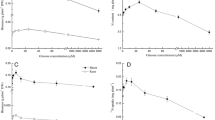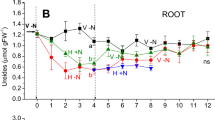Abstract
Root cultures of Senecio erucifolius (Asteraceae) efficiently took up and incorporated [14C]putrescine and [14C]arginine into the pyrrolizidine alkaloid (PA) senecionine N-oxide. Pulse-chase experiments covering a growth period of 10 to 19 days revealed the absence of any significant alkaloid turnover. The only metabolic activity was a slow but progressive transformation of senecionine N-oxide into its dehydrogenation product, seneciphylline N-oxide. Tracer experiments with single roots showed that the sites of enhanced PA synthesis coincided with the sites of preferred protein synthesis, i.e. root apices, indicating a close correlation between growth activity and alkaloid synthesis. Long-term pulse-chase experiments (10 to 12 days) with 14C-labelled arginine, putrescine and senecionine fed to single roots indicated that in spite of its metabolic inertia, senecionine N-oxide is a mobile compound which is translocated into tissues newly grown during the chase.
Similar content being viewed by others
References
Hartmann T, Toppel G (1987) Senecionine N-oxide, the primary product of pyrrolizidine alkaloid biosynthesis in root cultures of Senecio vulgaris. Phytochemistry 26: 1639–1643
Hartmann T, Zimmer M (1986) Organ-specific distribution and accumulation of pyrrolizidine alkaloids during the life history of two annual Senecio species. J Plant Physiol 122: 67–80
Hartmann T, Ehmke A, Eilert U, Borstel Kvon, Theuring C (1989) Sites of synthesis, translocation and accumulation of pyrrolizidine alkaloid N-oxides in Senecio vulgaris. Planta 177: 98–107
Ehmke A, Borstel Kvon, Hartmann T (1988) Alkaloid N-oxides as transport and vacuolar storage compounds of pyrrolizidine alkaloids in Senecio vulgaris L. Planta 176: 83–90
Toppel G, Witte L, Riebesehl B, Borstel Kvon, Hartmann T (1987) Alkaloid patterns and biosynthetic capacity of root cultures from some pyrrolizidine alkaloid producing Senecio species. Plant Cell Rep 6: 466–469
Hartmann T, Sander H, Adolph R, Toppel G (1988) Metabolic links between the biosynthesis of pyrrolizidine alkaloids and polyamines in root cultures of Senecio vulgaris. Planta 175: 82–90
Murashige T, Skoog F (1962) A revised medium for rapid growth and bioassays with tobacco tissue cultures. Physiol Plant 15: 473–497
Wagner J, Danzin C, Mamont P (1982) Reversed-phase ion-pair liquid chromatographic procedure for the simultaneous analysis of S-adenosylmethionine, its metabolites and the natural polyamines. J Chromatogr 227: 349–368
Vetter-Diechtl H, Vetter W, Richter W, Biemann K (1968) Ein für Massenspektrometrie und Gaschromatographie geeignetes Argininderivat. Experientia 24: 340–341
Galston AW (1983) Polyamines as modulators of plant development. BioScience 33: 382–388
Slocum RD, Kaur-Sawhney R, Galston AW (1984) The physiology and biochemistry of polyamines in plants. Arch Biochem Biophys 235: 283–303
Barz W, Köster J (1981) Turnover and degradation of secondary (natural) products. In: Corn EE (Ed) The Biochemistry of Plants. Vol 7. Secondary Plant Products (pp 35–84) Academic Press, New York
Robinson T (1974) Metabolism and function of alkaloids in plants. Science 184: 430–435
Waller GR, Nowacki E (1978) Alkaloid biology and metabolism in plants. Plenum, New York
Wink M (1987) Physiology of the accumulation of secondary metabolites with special reference to alkaloids. In: Vasil KV, Constabel F (Eds) Cell Culture and Somatic Cell Genetics of Plants (pp 17–42) Academic Press, New York
Boppré M (1986) Insects pharmacophagously utilizing defensive plant chemicals (pyrrolizidine alkaloids). Naturwissenschaften 73: 17–26
Schneider D (1987) The strange fate of pyrrolizidine alkaloids. In: Chapman RF, Bernays EA, Stoffolano JG (Eds) Perspectives in Chemoreception and Behavior (pp 123–142) Springer, New York
Author information
Authors and Affiliations
Additional information
Dedicated to Dr. Friedrich Constabel on the occasion of his 60th birthday
Rights and permissions
About this article
Cite this article
Sander, H., Hartmann, T. Site of synthesis, metabolism and translocation of senecionine N-oxide in cultured roots of Senecio erucifolius . Plant Cell Tiss Organ Cult 18, 19–31 (1989). https://doi.org/10.1007/BF00033462
Received:
Accepted:
Issue Date:
DOI: https://doi.org/10.1007/BF00033462




